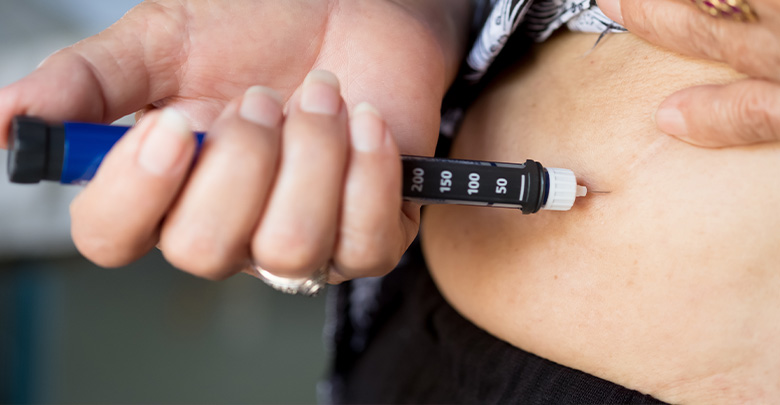Should Type 2 Insulin Therapy Start Sooner?
Insulin is the most effective drug to lower your blood sugar yet other medications are prescribed, even though less effective and more costly

Taking insulin via injection or pump has always been deemed as a sign of failure and last resort. Metformin is touted as the “first line of defense” and heavy marketing of new on-patent (and thus expensive) drugs captures doctor attention.
But research continues to show that early initiation of insulin in type 2 diabetes is essential for your long-term success in improving blood sugar levels and preventing devastating complications.
The study poses the following dilemma and question:
The majority of patients with type 2 diabetes fail to maintain glycemic goals over time after initial success with standard interventions; would early insulin initiation help?”
Why Early Insulin Therapy is Important
There are four major reasons research continues to encourage earlier insulin therapy for patients with type 2 diabetes.
- To immediately lower blood sugar levels and prevent further long-term damage to the body which cause diabetes complications (retinopathy, neuropathy, nephropathy, foot ulcers, etc.)
- To take reduce stress on insulin-producing beta-cells to enable these cells to function more effectively in the long-term after a patient makes strides in weight-loss, nutrition, and physical activity to lower their body’s overall demand for insulin.
- To compensate for the inevitable beta-cell dysfunction that occurs in approximately 60 percent of people with type 2 diabetes.
- To improve the long-term health of patients who struggle to make or adhere to lifestyle changes that would improve insulin sensitivity.
“The majority of patients with type 2 diabetes fail to maintain glycemic goals overtime after a successful initial response to therapy from weight reduction, diet, and oral medication (usually metformin),” explains the report on the study authored by Taylor-Eugene Simmons, Florida A&M University and led by Irl B. Hirsch, MD, professor of medicine at the University of Washington in Seattle, Washington.
“Adding a second- or third-line oral agent or an injectable, such as GLP-1 receptor agonists, SGLT2 inhibitors, or insulin are all therapeutic options to consider when needing to better manage blood glucose.”
Hirsch highlights that improvements in the non-insulin medication options have helped greatly. While metformin has been the go-to therapy for decades, it fails in many ways and comes with terrible digestive side-effects that lead many patients to stop taking it.
GLP-1 receptor agonists (like Victoza, Ozempic, and Trulicity) and SGLT2 inhibitors (like Invokana, Invokamet, and Farxiga) offer patients with type 2 diabetes much more than metformin could, but for many, they are still not enough.
While insulin therapy is often viewed as the “last resort” for patients with type 2 diabetes, the report on Hirsch’s research argues the opposite: “Insulin is far from outdated and may be needed before second-line agents such as GLP-1 receptor agonists and SGLT2 inhibitors.”
Clinical inertia and Oral Diabetes Medications
This most recent research is well supported by many other studies highlighting the benefits of insulin therapy for those with type 2 diabetes.
- “As beta-cell dysfunction progresses over time, many patients with type 2 diabetes, treated with oral agents, fail to achieve or maintain adequate glycemic control,” explains 2009 research.
- “Unfortunately, in many of these cases, anti-glycemic therapy is not adjusted or advanced, thereby exposing patients to prolonged hyperglycemia and the increased risk of diabetes-related complications.”
This past research points to “clinical inertia” in the management of a patient’s type 2 diabetes — when blood sugar levels continue to be higher than safe levels but the healthcare team does not make necessary changes to the patient’s medication regimen.
Very recent research found a variety of potential reasons that could leave a patient with persistently high blood sugar levels and little-to-no intervention changes from their healthcare team:
- The relationship between patient & healthcare provider
- The patient’s health insurance coverage
- The overall healthcare coverage system in the USA
- The overall healthcare system and logistics
- The overall financial burden a patient faces when trying to pay for medications, supplies, and appointments
For many of these patients, Hirsch’s recent research would indicate these patients would be ideal candidates for insulin therapy based on blood sugar levels rather than continuing to take oral agents like metformin.
Oral medication patients with poor blood sugar control are ideal candidates for insulin therapy.
A1c Determines the Need for Insulin therapy
For patients with an A1c of 9% or higher, the researchers feel insulin should be highly recommended, and an A1c over 10% should deem insulin therapy absolutely necessary.
Hirsch also feels strongly that starting a patient on insulin earlier reduces their risk of heart attacks or other cardiac events and spares them from permanent microvascular damage.
He asked his colleagues during his presentation on his research, “Why not consider basal insulin at least to get the glucose toxicity down to reduce glucose levels for a short period?”
Balancing Risk
Concerns for starting insulin therapy, regardless of when it is started, include hypoglycemia and weight gain.
These factors need to be taken into account when considering putting a patient on insulin therapy.
- Drug interactions. For example, the combination of a GLP-1 receptor agonist with insulin creates a significant risk for hypoglycemia because both medications lower blood sugar directly, while SGLT2s do not pose this risk because they act differently; clearing excess sugar from the bloodstream via urine.
- For some patients — especially senior citizens — the risk of hypoglycemia may be more important than reducing their A1c, which is why Hirsch encourages personalized A1c goals rather than the generic goal of 7.0 percent proposed by the American Diabetes Association.
For people with A1c levels over 9 percent, lifestyle changes and metformin simply aren’t enough and take too long to bring blood sugars down to safer levels for the patient’s long-term health.
Hygieia Rewriting Advanced T2D Care!
One company is building a large business by treating almost exclusively with insulin. Hygieia works with the high-risk patient for insurance firms in Michigan to
Their formula is based on guidance provided by insulin manufacturers, as well as clinical evidence and guidance from the American Diabetes Association (ADA). For most patients, this translates into:
- More insulin; often 3x the common dose first prescribed
- Dosing titration that changes frequently based on tracking BG
The typical Hygieia patient weighs 220 pounds and gets 160-170 units of insulin per day; way above the national average T2D dose of 60 units per day. This partially explains why average HbA1c for patients at their d-Nav Care Centers is 7.1% compared to ~8.5% elsewhere.
Read the full Hygieia article here.





